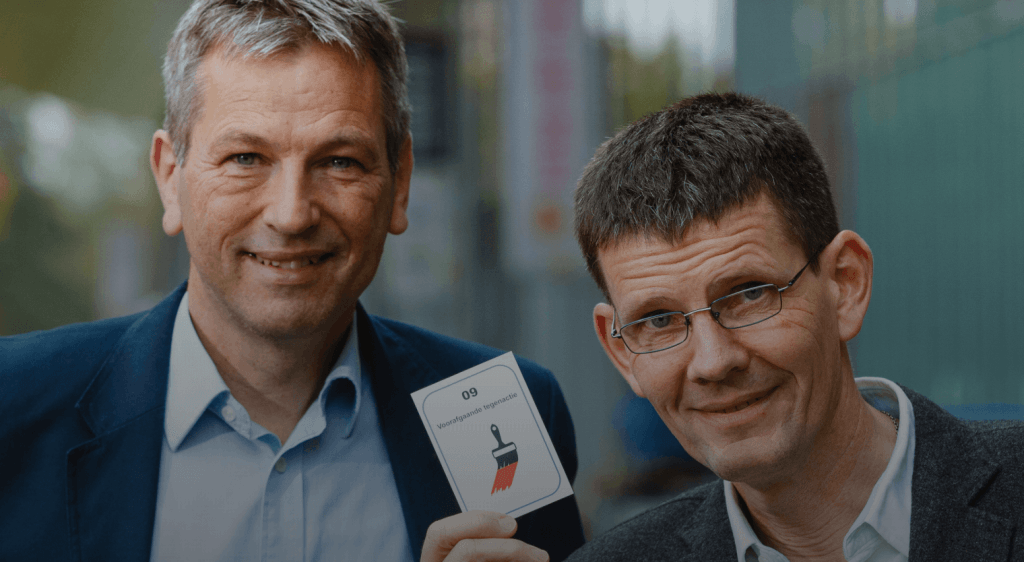
The ‘TRIZ’ method helps Philips and Brainport Schools in their daily search for solutions
Many Brainports schools use “TRIZ” as a means of stimulating creativity among their pupils. Since the start of the programme a few years ago, Philips has been involved in supervising the TRIZ teachers at the Brainports schools. For Christoph Dobrusskin (Philips) and Hans Baaijens (Philips Lighting, which recently changed its name to Signify), it was a logical step: the method that was devised to give people a handle on how to think more creatively is also extremely suitable for secondary schools.
TRIZ (a Russian abbreviation that means “theory of inventive problem solving”) stimulates creativity in everyone who faces dilemmas and problems. “Everyone is an inventor with TRIZ”, says Dobrusskin. “And anyone can be creative. Often people think that they can’t do that if they have been limited in their actions. The opposite is true: these curtailments give you focus and help you to be more creative. And that is where TRIZ helps.”
The inventor of TRIZ was a Russian patent official, Gerich Altshuller, who discovered patterns in patent applications. He distilled a total of 40 principles, which now provide generic solution strategies for any problem. Designed for engineering, TRIZ has been made suitable for anyone who wants to solve creative problems. Dobrusskin and Baaijens have further adapted it so that it also works for secondary school education; the Brainport schools are now taking full advantage of it. The initiative was launched in 2014 as part of the Philips JetNet activities.
40 playing cards
Hans Baaijens and Christoph Dobrusskin have brought along an example: a package of 40 playing cards. But instead of jacks, queens, and kings, the cards show the forty TRIZ principles, with examples of their applications on the back side. It is one of the tools of TRIZ; the maps give very concrete tips, such as “Segment your product, isolating a useful or harmful property”, or “Compensate a negative property of the product with an opposite force”. Baaijens: “The 40 principles that emerged from this are like a compass, a route planner to solutions to problems.”
“The fact that TRIZ has been so widely and willingly adopted by Brainport schools lately is mainly a matter of mouth-to-mouth advertising,” says Baaijens, who is responsible for new product concepts at Signify in his daily life. “And not to forget the enthusiasm of Josette Linssen, former rector of the Heerbeeck College. Three years ago, she brought us into contact with other teachers. Meanwhile, also through cooperation with Mandy Stoop and the Fontys teacher training college in Tilburg, hundreds of teachers have visited us. You can therefore say that there is a solid basis for TRIZ in the programme of the Brainport schools and the education sector.”
Baaijens was inspired years ago by TRIZ training courses within Philips and immediately saw the potential of TRIZ for education. Dobrusskin has the second-highest level of TRIZ mastery and is a member of the international TRIZ board. He successfully introduced the system to Philips, where he is now working in the development of mother and child care products. “The big advantage of TRIZ is that it makes people’s creativity even stronger, so much so that everyone can be an inventor with TRIZ”, says Dobrusskin.
Baaijens adds: “TRIZ shows you as many directions as possible that you can take in order to solve a problem. It says ‘try this now, or that, look at it from a different perspective’. TRIZ breaks through your tunnel vision. It originates from the engineering world, but everyone can use it, whether you use it for product development, education or even cooking. Where additional options can help, it can play a role. It also helps, above all, with seemingly contradictory solutions, with dilemmas of which one solution directly leads to a new problem. Take, for example, the car industry: you want to drive safely, but also comfortably. A kind of army tank could be the solution for the first, but it is counterproductive for the second. This is how the airbag was conceived: safety, but not at the expense of comfort.”
Dobrusskin points to three steps that are important in any troubleshooting process. “Whatever you do, look at your customer group first. You have to know what their expectations are. Then you analyse your assumptions and distil the facts from them. As a last step, you come to the solutions. Then you can use the ‘catalogue of ideas’: the TRIZ principles. Applied in education, the good thing is that the whole class can participate. This is emphatically not something for just the smart or creative children; with this system everyone is creative.”
“Everyone is creative with this system”
According to Baaijens and Dobrusskin, the fact that it did not enter education much earlier is mainly due to the fact that it is a kind of meta-method. “It is interesting for all subjects, not for a specific one. This makes it more difficult to fit into the current educational structure”, says Dobrusskin. “Furthermore, at school everything is focused on the ‘right answer’, whatever class you teach. And then we enter the scene with our story that you have no idea where your solution might lead you to. You’re going on an adventure, maybe there are a lot of good answers; that requires a totally new attitude from the teacher.” Baaijens sees another reason: “Until recently, the theory behind TRIZ was quite complicated. A lot of technical language, not really fittable into the schoolbooks. That is why we are now working hard on translating it for use at school. We are working on a book and we are working together with the TU/e teacher training programme, which wants to do scientific research into the method itself.”
The importance of learning creative problem-solving thinking is also confirmed by a study carried out by Oxford University. “It shows that for the future of human work it is much more important to have solution-oriented skills than specific knowledge.”
For the introductory lesson of TRIZ, which takes one to two hours, Baaijens and Dobrusskin have already been able to guide hundreds of teachers in the world of TRIZ. “Not only secondary education but also the Fontys teacher training college in Tilburg is committed to teaching their teachers. It ends up with the pupils themselves.” Dobrusskin: “Take Brainport Class of Excellence, a group of children who follow an extra programme, including many company visits to the region. They received their TRIZ class halfway through the school year, in January. And it was very clear: during the company visits that took place afterward, they knew exactly what to do, even though it was much more difficult. They had learned how to analyse and solve problems.”
Teaching a systematic method for creative problem solving prepares young people for the future, for example for a career in industry at companies such as Philips and Signify. They can also use the skill for practical assignments and profile pieces. Baaijens and Dobrusskin: “We show that solving difficult problems, as we encounter them every day at Philips, can be very exciting and fun. The TRIZ skills can also always be used by the students to think along and solve current issues of Philips and Signify. For example, students can apply TRIZ during the Grand Challenge Assignment, in which the Brainport students are going to encounter the question: how do you create attractive shops with modern light and data technology? The way in which we explain the TRIZ method attractively to students and teachers in a short period of time also finds its way back to Philips and helps us in our daily work with TRIZ.”
For Hans Baaijens and Christoph Dobrusskin, ‘TRIZ for schools’ is a project that often takes place alongside their normal work. “There is still a lot of work to be done to give the method of creative problem solving a more permanent fundament in education. It is more than worth doing, given the enthusiastic reactions we get and the positive energy it gives to everyone. The workshops are always held in a very lively atmosphere.”








